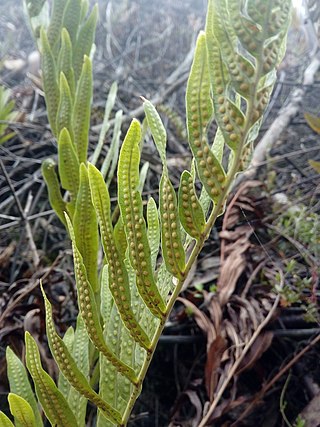
Dioscorea is a genus of over 600 species of flowering plants in the family Dioscoreaceae, native throughout the tropical and warm temperate regions of the world. The vast majority of the species are tropical, with only a few species extending into temperate climates. It was named by the monk Charles Plumier after the ancient Greek physician and botanist Dioscorides.
Phaseolus rimbachii is a species of legume in the family Fabaceae. It is found only in Ecuador. Its natural habitat is subtropical or tropical moist montane forests.
Eschweilera rimbachii is a species of woody plant in the family Lecythidaceae. It is found in Colombia and Ecuador.
Grosvenoria rimbachii is a species of flowering plant in the family Asteraceae. It is found only in Ecuador. Its natural habitats are subtropical or tropical moist montane forests and subtropical or tropical high-altitude grassland. It is threatened by habitat loss.
Gynoxys rimbachii is a species of flowering plant in the family Asteraceae. It is found only in Ecuador. Its natural habitat is subtropical or tropical moist montane forests. It is threatened by habitat loss.
Mutisia rimbachii is a species of flowering plant in the family Asteraceae. It is found only in Ecuador. Its natural habitat is subtropical or tropical high-altitude shrubland. It is threatened by habitat loss.
Aegiphila rimbachii is a species of tree in the family Lamiaceae. It is endemic to Bolívar Province in Ecuador, where it grows in the cloud forests of the Andes.

Anthurium rimbachii is a species of plant in the family Araceae. It is endemic to Ecuador. Its natural habitat is subtropical or tropical moist lowland forests. It is threatened by habitat loss.

Austroblechnum divergens, synonyms including Blechnum divergens, Blechnum rimbachii and Blechnum floresii, is a species of fern in the family Blechnaceae.
Centropogon rimbachii is a species of plant in the family Campanulaceae. It is endemic to Ecuador. Its natural habitat is subtropical or tropical moist montane forests. It is threatened by habitat loss.
Lycianthes rimbachii is a species of plant in the family Solanaceae. It is endemic to Ecuador.
Miconia rimbachii is a species of plant in the family Melastomataceae. It is endemic to Ecuador. Its natural habitat is subtropical or tropical moist montane forests.

Serpocaulon sessilifolium is a species of fern in the family Polypodiaceae. It is native to Costa Rica and northern and western South America. Under the synonym Polypodium rimbachii, it was regarded as endemic to Ecuador and threatened by habitat loss.
Psychotria rimbachii is a species of plant in the family Rubiaceae. It is endemic to Ecuador.
Symplocos rimbachii is a species of plant in the family Symplocaceae. It is endemic to Ecuador. Its natural habitat is subtropical or tropical moist montane forest.
Dioscorea ovinala is a species of yam in the family Dioscoreaceae. It is endemic to Madagascar and grows mostly in dry deciduous forests.
Dioscorea chimborazensis is a type of yam in the family Dioscoreaceae. It is endemic to Ecuador.
Dioscorea rosei is a vine in the family Dioscoreaceae. It is endemic to Ecuador and it is threatened by habitat destruction.
Dioscorea acuminata is a herbaceous vine in the family Dioscoreaceae, which is listed as an endangered species by the IUCN Red List. It is indigenous to the central plateau of Madagascar where it occurs on rocky substrate in a grassland-woodland mosaic habitat. There is confusion as to whether the tuber is harvested for consumption by humans as field researchers likely misidentified Dioscorea maciba as this species. However, the IUCN Red List also has an entry for D. maciba which does not cite that species as being consumed by humans.
Dioscorea alatipes is a herbaceous vine in the genus Dioscorea. It is indigenous to the Morondava Prefecture in Madagascar and is listed as an vulnerable on the IUCN Red List in 2017, having previously been listed as endangered in 2001. It has been confused with another Dioscorea species, D. bako which is a food source of the indigenous people of the region. D. alatipes is found growing in forested areas on sandy soils or on limestone substrate. This species is managed for human consumption as part of the SuLaMa Project. According to the IUCN, the species is threatened by overharvesting of the tubers as well as by the expansion of farmland in the area.




